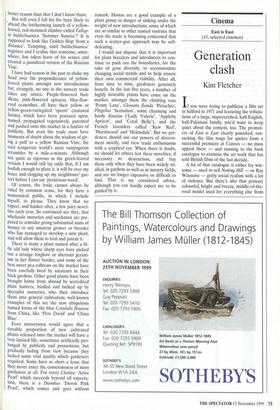Gardens
Unwelcome novelties
Ursula Buchan
It is a quirk of personality from which, annually, self-knowledge fails to protect me. Faced with the opportunity to replant (having expelled serial defaulters and the irredeemably second rate) I avoid choosing plants that I know as being old hat and without excitement and plump instead for novelties, discovered in the pages of a nurs- ery catalogue, on a bright, cutesy website, or prominent display in a garden centre. As if there were not enough plants with which I am already familiar, I find I want those that I have not seen before, for no better reason than that I don't know them. But will even I fall for the hype likely to attend the forthcoming launch of a yellow- leaved, red-stemmed climber called Fallop- ia baldschuanica 'Summer Sunrise'? It is supposed to look like Golden Hop 'from a distance'. Tempting, until `baldschuanica' registers and I realise that someone, some- where, has taken leave of his senses and created a jaundiced version of the Russian Vine.
I have had reason in the past to shake my head over the preponderance of yellow- leaved plants amongst new introductions but, strangely, no one in the nursery trade takes any notice. Purple-flowered bud- dleias, pink-flowered spiraeas, blue-flow- ered ceanothus, all have their yellow or yellow-green-variegated 'sports' (mutated forms), which have been pounced upon, named, propagated vegetatively, patented and pushed onto the market in a fanfare of publicity. But even the trade must have moments of doubt about the wisdom of giv- ing a puff to a yellow Russian Vine, the cool temperate world's most rampageous scrambler by a mile-a-minute. Although not quite as vigorous as the green-leaved version I would still lay odds that, if I am foolish enough to plant it, it will be over my fence and clogging up my neighbours' gut- ters before I can say 'pernicious weed'.
Of course, the trade cannot always be ruled by common sense, for they have a nonsensical public, in which I include myself, to please. They know that we expect, and hanker after, a few juicy novel- ties each year. So convinced are they, that Wholesale nurseries and seedsmen are pre- pared to consider giving substantial sums of money to any amateur grower or breeder who has managed to develop a new plant, and will allow them to trial and patent it.
There is many a plant named after a lit- tle old lady whose sharp eyes have picked out a strange foxglove or aberrant gerani- um in her flower border, and some of the best sweet pea cultivars on the market have been carefully bred by amateurs in their back gardens. Other good plants have been brought home from abroad by accredited plant hunters, trialled and bulked up by specialist nurseries, who then introduce them into general cultivation; well-known examples of this are the now ubiquitous named forms of the blue Corydalis flexuosa from China, like 'Pere David' and 'China Blue'.
Even nurserymen would agree that a sizeable proportion of new cultivated Plants released onto the market will have a very limited life, sometimes artificially pro- longed by publicity and promotions, but gradually fading from view because they lacked some vital quality which gardeners required. Some have so short a lease that they never enter the consciousness of most
gardeners at all. For every Choisya 'Aztec Pearl' which succeeds beyond all expecta- tion, there is a Dianthus 'Devon Pink Pearl', which comes and goes without
remark. Hostas are a good example of a plant group in danger of sinking under the weight of new introductions, some of which are so similar to other named varieties that even the trade is becoming concerned that such a scatter-gun approach may be self- defeating.
I would not dispute that it is important for plant breeders and introducers to con- tinue to push out the boundaries, for the sake of gene diversity, to accommodate changing social trends and to help ensure their own commercial viability. After all, from time to time, gardeners genuinely benefit. In the last five years, a number of highly desirable plants have come on the market, amongst them the climbing rose 'Penny Lane', Clematis florida 'Pistachio', Phygelius 'Sensation', some charming and hardy diascias ('Lady Valerie', 'Appleby Apricot', and 'Coral Belle'), and the French lavenders called 'Kew Red', 'Marshwood' and 'Helmsdale'. But we gar- deners should use our powers of discern- ment strictly, and view trade enthusiasms with a sceptical eye. When there is doubt, we should let others test these novelties, if necessary to destruction, and buy them only when they have been widely tri- alled, in gardens as well as in nursery fields, and are no longer expensive or difficult to find. That is my considered advice, although you can hardly expect me to be guided by it.



























































































 Previous page
Previous page